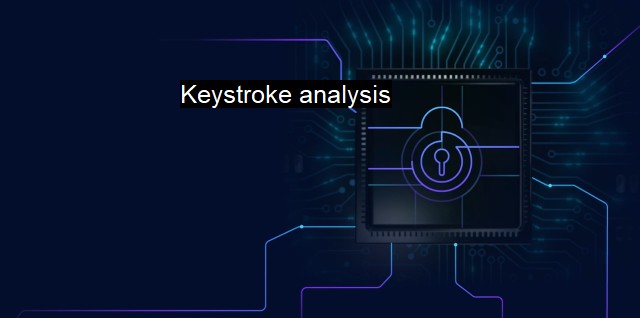What are Keystroke analysis?
Keystroke Analysis: Advancements in Cybersecurity Identification and Prevention Techniques
Keystroke analysis, used in the context of cybersecurity and antivirus mechanisms, is the detailed review and evaluation of the typing style and rhythm of a computer user. It is a user authentication method that monitors and identifies unique patterns and rhythms in a person's typing or input to determine and verify the user's identity. This method is commonly used in instances of continuous authentication, cybersecurity systems, and antivirus mechanisms.The measurement property of keystroke dynamics is centered around 'dwell time' and 'flight time.' Dwell time analyses the duration that a specific key is pressed before being released, while flight time calculates the duration between releasing a key and pressing the next one. These intricate details define the unique keystroke patterns of an individual.
Keystroke dynamics can serve as an authentication mechanism for cybersecurity purposes. The intent behind this is to establish an additional layer of security to traditional password methods. For instance, even if a malicious entity manages to learn the password, they would struggle to mimic the legitimate user's unique typing pattern accurately.
More pertinently, keystroke analysis becomes markedly valuable in its implementation within antivirus system processes. It is used to track, analyse, and safeguard a computer user's keystrokes from potential intruders and cyber threats such as keyloggers. Keyloggers are malicious programs that track a user’s keystrokes and clandestinely send the data to an attacker. They pose a significant threat to cybersecurity, as they can capture very sensitive information, including login credentials, credit card details, and other private data. Although the firewall or antivirus software might be able to prevent many of these threats, some may sneak past these defenses unnoticed.
This is where keystroke dynamics enter the picture. By analyzing how certain keystrokes are pressed and released over time, keystroke dynamics can build up profiles of how individuals typically engage with their keyboard. When requested to present authorization, users would have to provide not just their credentials, but also their unique keystroke dynamics—something closely resembling a digital gait analysis.
Confidence scores can be calculated automatically to match user profiles with ongoing input, resulting in a continuous and unobtrusively dynamic form of authentication. In case the typing pattern quickly differs from the usual data, as would be the case if an unauthorized person or even a keylogging malware manages to breach the system and covertly record keystrokes, the system could then discern this unfamiliar input as potentially hazardous and either lock out the interface or prompt another round of authentication.
Nonetheless, it's worth mentioning that keystroke dynamics should not be seen as an all-in-one cybersecurity solution, mainly because it's user-dependent and users have different typing behavior. Alternatively, it needs to be deployed in conjunction with multi-factor authentication procedures and other antivirus mechanisms for enhanced data security.
While not infallible, keystroke analysis is a non-invasive method of protecting user data and upholding cybersecurity. It adds another level of sophistication to a multi-layered, integrated security framework that includes antivirus software. Its intelligence lies in its ability to provide dynamic authentication mechanisms that adapt to a user’s pattern and rhythm of keystrokes, making it difficult for cybercriminals to defeat.

Keystroke analysis FAQs
What is keystroke analysis in cybersecurity?
Keystroke analysis is the process of analyzing the typing patterns and habits of an individual to identify potential security threats. It involves monitoring and logging keystrokes to detect suspicious activity such as unauthorized access, phishing, or data theft.How does keystroke analysis help in detecting malware attacks?
Keystroke analysis can help identify malware attacks by detecting abnormal patterns in keystrokes, such as multiple keystrokes for a single command, repetitive keystrokes, or unusually fast typing. It can also detect the presence of keyloggers, which are malicious programs that record keystrokes and steal sensitive information.What are the benefits of using keystroke analysis in antivirus software?
Keystroke analysis can enhance the capabilities of antivirus software by providing an additional layer of protection against unknown threats. It can help detect zero-day attacks and advanced persistent threats (APTs) that traditional antivirus tools may miss. It can also improve the accuracy of intrusion detection systems and enable faster threat response.What are the privacy concerns associated with keystroke analysis?
Keystroke analysis can raise privacy concerns, as it involves collecting and analyzing data about an individual's computer usage. It is important to ensure that the collected data is used only for security purposes and is protected from unauthorized access. Users should be informed and given the option to opt-out of keystroke analysis if they have concerns about their privacy.| | A | | | B | | | C | | | D | | | E | | | F | | | G | | | H | | | I | | | J | | | K | | | L | | | M | |
| | N | | | O | | | P | | | Q | | | R | | | S | | | T | | | U | | | V | | | W | | | X | | | Y | | | Z | |
| | 1 | | | 2 | | | 3 | | | 4 | | | 7 | | | 8 | | |||||||